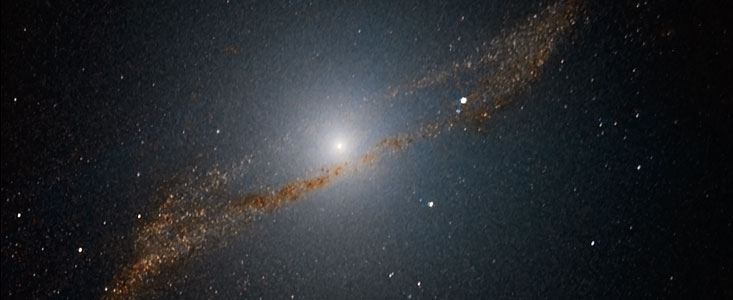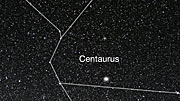Press Release
Watching a Cannibal Galaxy Dine
20 November 2009
A new technique using near-infrared images, obtained with ESO’s 3.58-metre New Technology Telescope (NTT), allows astronomers to see through the opaque dust lanes of the giant cannibal galaxy Centaurus A, unveiling its “last meal” in unprecedented detail — a smaller spiral galaxy, currently twisted and warped. This amazing image also shows thousands of star clusters, strewn like glittering gems, churning inside Centaurus A.
Centaurus A (NGC 5128) is the nearest giant, elliptical galaxy, at a distance of about 11 million light-years. One of the most studied objects in the southern sky, by 1847 the unique appearance of this galaxy had already caught the attention of the famous British astronomer John Herschel, who catalogued the southern skies and made a comprehensive list of nebulae.
Herschel could not know, however, that this beautiful and spectacular appearance is due to an opaque dust lane that covers the central part of the galaxy. This dust is thought to be the remains of a cosmic merger between a giant elliptical galaxy and a smaller spiral galaxy full of dust.
Between 200 and 700 million years ago, this galaxy is indeed believed to have consumed a smaller spiral, gas-rich galaxy — the contents of which appear to be churning inside Centaurus A's core, likely triggering new generations of stars.
First glimpses of the “leftovers” of this meal were obtained thanks to observations with the ESA Infrared Space Observatory, which revealed a 16 500 light-year-wide structure, very similar to that of a small barred galaxy. More recently, NASA’s Spitzer Space Telescope resolved this structure into a parallelogram, which can be explained as the remnant of a gas-rich spiral galaxy falling into an elliptical galaxy and becoming twisted and warped in the process. Galaxy merging is the most common mechanism to explain the formation of such giant elliptical galaxies.
The new SOFI images, obtained with the 3.58-metre New Technology Telescope at ESO’s La Silla Observatory, allow astronomers to get an even sharper view of the structure of this galaxy, completely free of obscuring dust. The original images, obtained by observing in the near-infrared through three different filters (J, H, K) were combined using a new technique that removes the dark, screening effect of the dust, providing a clear view of the centre of this galaxy.
What the astronomers found was surprising: “There is a clear ring of stars and clusters hidden behind the dust lanes, and our images provide an unprecedentedly detailed view toward it,” says Jouni Kainulainen, lead author of the paper reporting these results. “Further analysis of this structure will provide important clues on how the merging process occurred and what has been the role of star formation during it.”
The research team is excited about the possibilities this new technique opens: “These are the first steps in the development of a new technique that has the potential to trace giant clouds of gas in other galaxies at high resolution and in a cost-effective way,” explains co-author João Alves. “Knowing how these giant clouds form and evolve is to understand how stars form in galaxies.”
Looking forward to the new, planned telescopes, both on the ground and in space, “this technique is very complementary to the radio data ALMA will collect on nearby galaxies, and at the same time it poses interesting avenues of research for extragalactic stellar populations with the future European Extremely Large Telescope and the James Webb Space Telescope, as dust is omnipresent in galaxies,” says co-author Yuri Beletsky.
Previous observations done with ISAAC on the VLT have revealed that a supermassive black hole lurks inside Centaurus A. Its mass is about 200 million times the mass of our Sun, or 50 times more massive than the one that lies at the centre of our Milky Way. In contrast to our own galaxy, the supermassive black hole in Centaurus A is continuously fed by material falling onto into it, making the giant galaxy a very active one. Centaurus A is in fact one of the brightest radio sources in the sky (hence the “A” in its name). Jets of high energy particles from the centre are also observed in radio and X-ray images.
The new image of Centaurus A is a wonderful example of how frontier science can be combined with aesthetic aspects. Fine images of Centaurus A have been obtained in the past with ESO’s Very Large Telescope and with the Wide Field Imager on the MPG/ESO 2.2-metre telescope at La Silla and the FORS2 instrument on the Very Large Telescope (VLT) at Paranal.
More information
This research was presented in a paper in Astronomy and Astrophysics (vol. 502): “Uncovering the kiloparsec-scale stellar ring of NGC5128”, by J.T. Kainulainen et al.
The team is composed of J. T. Kainulainen (University of Helsinki, Finland, and MPIA, Germany), J. F. Alves (Calar Alto Observatory, Spain and University of Vienna, Austria), Y. Beletsky (ESO), J. Ascenso (Harvard-Smithsonian Center for Astrophysics, USA), J. M. Kainulainen (TKK/Department of Radio Science and Engineering, Finland), A. Amorim, J. Lima, F. D. Santos, and A. Moitinho (SIM-IDL, University of Lisbon, Portugal), R. Marques and J. Pinhão (University of Coimbra, Portugal), and J. Rebordão (INETI, Amadora, Portugal).
SOFI (Son of ISAAC) is an infrared spectro-imager attached to ESO's 3.58-metre New Technology Telescope (NTT) and a simplified version of the Short Wavelength arm of ISAAC on the Very Large Telescope.
ESO, the European Southern Observatory, is the foremost intergovernmental astronomy organisation in Europe and the world’s most productive astronomical observatory. It is supported by 14 countries: Austria, Belgium, Czechia, Denmark, France, Finland, Germany, Italy, the Netherlands, Portugal, Spain, Sweden, Switzerland and the United Kingdom. ESO carries out an ambitious programme focused on the design, construction and operation of powerful ground-based observing facilities enabling astronomers to make important scientific discoveries. ESO also plays a leading role in promoting and organising cooperation in astronomical research. ESO operates three unique world-class observing sites in Chile: La Silla, Paranal and Chajnantor. At Paranal, ESO operates the Very Large Telescope, the world’s most advanced visible-light astronomical observatory. ESO is the European partner of a revolutionary astronomical telescope ALMA, the largest astronomical project in existence. ESO is currently planning a 42-metre European Extremely Large optical/near-infrared Telescope, the E-ELT, which will become “the world’s biggest eye on the sky”.
Links
- Science paper: http://www.aanda.org/10.1051/0004-6361/200912624
- More about Cen A: http://www.extragalactic.info/cena/
Contacts
Jouni Kainulainen
MPIA
Germany
Tel: +49-6221-528427
Email: jtkainul@mpia-hd.mpg.de
Yuri Beletsky
ESO
Chile
Tel: +56 55 43 5311
Email: ybialets@eso.org
João Alves
Calar Alto Observatory
Spain
Tel: +34 950 632 501
Email: jalves@caha.es
About the Release
| Release No.: | eso0944 |
| Legacy ID: | PR 44/09 |
| Name: | Centaurus A, NGC 5128 |
| Type: | Local Universe : Galaxy : Type : Elliptical Local Universe : Galaxy : Component : Central Black Hole |
| Facility: | New Technology Telescope, Very Large Telescope |
| Instruments: | NACO, SOFI |
| Science data: | 2009A&A...502L...5K |
Our use of Cookies
We use cookies that are essential for accessing our websites and using our services. We also use cookies to analyse, measure and improve our websites’ performance, to enable content sharing via social media and to display media content hosted on third-party platforms.
ESO Cookies Policy
The European Organisation for Astronomical Research in the Southern Hemisphere (ESO) is the pre-eminent intergovernmental science and technology organisation in astronomy. It carries out an ambitious programme focused on the design, construction and operation of powerful ground-based observing facilities for astronomy.
This Cookies Policy is intended to provide clarity by outlining the cookies used on the ESO public websites, their functions, the options you have for controlling them, and the ways you can contact us for additional details.
What are cookies?
Cookies are small pieces of data stored on your device by websites you visit. They serve various purposes, such as remembering login credentials and preferences and enhance your browsing experience.
Categories of cookies we use
Essential cookies (always active): These cookies are strictly necessary for the proper functioning of our website. Without these cookies, the website cannot operate correctly, and certain services, such as logging in or accessing secure areas, may not be available; because they are essential for the website’s operation, they cannot be disabled.
Functional Cookies: These cookies enhance your browsing experience by enabling additional features and personalization, such as remembering your preferences and settings. While not strictly necessary for the website to function, they improve usability and convenience; these cookies are only placed if you provide your consent.
Analytics cookies: These cookies collect information about how visitors interact with our website, such as which pages are visited most often and how users navigate the site. This data helps us improve website performance, optimize content, and enhance the user experience; these cookies are only placed if you provide your consent. We use the following analytics cookies.
Matomo Cookies:
This website uses Matomo (formerly Piwik), an open source software which enables the statistical analysis of website visits. Matomo uses cookies (text files) which are saved on your computer and which allow us to analyze how you use our website. The website user information generated by the cookies will only be saved on the servers of our IT Department. We use this information to analyze www.eso.org visits and to prepare reports on website activities. These data will not be disclosed to third parties.
On behalf of ESO, Matomo will use this information for the purpose of evaluating your use of the website, compiling reports on website activity and providing other services relating to website activity and internet usage.
Matomo cookies settings:
Additional Third-party cookies on ESO websites: some of our pages display content from external providers, e.g. YouTube.
Such third-party services are outside of ESO control and may, at any time, change their terms of service, use of cookies, etc.
YouTube: Some videos on the ESO website are embedded from ESO’s official YouTube channel. We have enabled YouTube’s privacy-enhanced mode, meaning that no cookies are set unless the user actively clicks on the video to play it. Additionally, in this mode, YouTube does not store any personally identifiable cookie data for embedded video playbacks. For more details, please refer to YouTube’s embedding videos information page.
Cookies can also be classified based on the following elements.
Regarding the domain, there are:
- First-party cookies, set by the website you are currently visiting. They are stored by the same domain that you are browsing and are used to enhance your experience on that site;
- Third-party cookies, set by a domain other than the one you are currently visiting.
As for their duration, cookies can be:
- Browser-session cookies, which are deleted when the user closes the browser;
- Stored cookies, which stay on the user's device for a predetermined period of time.
How to manage cookies
Cookie settings: You can modify your cookie choices for the ESO webpages at any time by clicking on the link Cookie settings at the bottom of any page.
In your browser: If you wish to delete cookies or instruct your browser to delete or block cookies by default, please visit the help pages of your browser:
Please be aware that if you delete or decline cookies, certain functionalities of our website may be not be available and your browsing experience may be affected.
You can set most browsers to prevent any cookies being placed on your device, but you may then have to manually adjust some preferences every time you visit a site/page. And some services and functionalities may not work properly at all (e.g. profile logging-in, shop check out).
Updates to the ESO Cookies Policy
The ESO Cookies Policy may be subject to future updates, which will be made available on this page.
Additional information
For any queries related to cookies, please contact: pdprATesoDOTorg.
As ESO public webpages are managed by our Department of Communication, your questions will be dealt with the support of the said Department.




